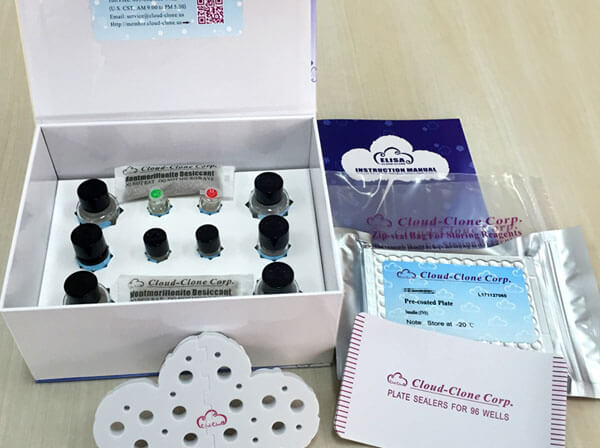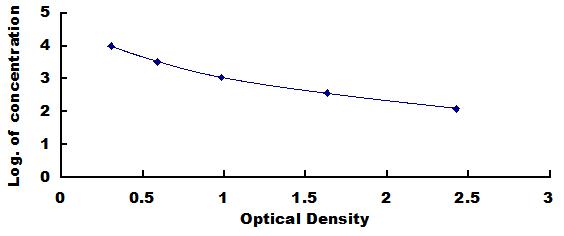ELISA Kit for Claudin 3 (CLDN3) 

C7orf1; CPE-R2; CPETR2; HRVP1; RVP1; Clostridium Perfringens Enterotoxin Receptor 2; Ventral Prostate.1-Like Protein; CPE-Receptor 2
- UOM
- FOB US$ 560.00 US$ 800.00 US$ 3,600.00 US$ 6,800.00 US$ 56,000.00
- Quantity
Overview
Properties
- Product No.CEF293Ca
- Organism SpeciesCanis familiaris; Canine (Dog) Same name, Different species.
- ApplicationsEnzyme-linked immunosorbent assay for Antigen Detection.
Research use only - DownloadInstruction Manual
- CategorySignal transduction
Sign into your account
Share a new citation as an author
Upload your experimental result
Review

Contact us
Please fill in the blank.
Recovery
Matrices listed below were spiked with certain level of recombinant Claudin 3 (CLDN3) and the recovery rates were calculated by comparing the measured value to the expected amount of Claudin 3 (CLDN3) in samples.
| Matrix | Recovery range (%) | Average(%) |
| serum(n=5) | 96-103 | 101 |
| EDTA plasma(n=5) | 78-92 | 88 |
| heparin plasma(n=5) | 90-104 | 101 |
Precision
Intra-assay Precision (Precision within an assay): 3 samples with low, middle and high level Claudin 3 (CLDN3) were tested 20 times on one plate, respectively.
Inter-assay Precision (Precision between assays): 3 samples with low, middle and high level Claudin 3 (CLDN3) were tested on 3 different plates, 8 replicates in each plate.
CV(%) = SD/meanX100
Intra-Assay: CV<10%
Inter-Assay: CV<12%
Linearity
The linearity of the kit was assayed by testing samples spiked with appropriate concentration of Claudin 3 (CLDN3) and their serial dilutions. The results were demonstrated by the percentage of calculated concentration to the expected.
| Sample | 1:2 | 1:4 | 1:8 | 1:16 |
| serum(n=5) | 79-89% | 81-94% | 99-105% | 80-103% |
| EDTA plasma(n=5) | 97-105% | 86-104% | 90-97% | 89-103% |
| heparin plasma(n=5) | 93-102% | 78-98% | 80-92% | 87-94% |
Stability
The stability of kit is determined by the loss rate of activity. The loss rate of this kit is less than 5% within the expiration date under appropriate storage condition.
To minimize extra influence on the performance, operation procedures and lab conditions, especially room temperature, air humidity, incubator temperature should be strictly controlled. It is also strongly suggested that the whole assay is performed by the same operator from the beginning to the end.
Reagents and materials provided
| Reagents | Quantity | Reagents | Quantity |
| Pre-coated, ready to use 96-well strip plate | 1 | Plate sealer for 96 wells | 4 |
| Standard | 2 | Standard Diluent | 1×20mL |
| Detection Reagent A | 1×120µL | Assay Diluent A | 1×12mL |
| Detection Reagent B | 1×120µL | Assay Diluent B | 1×12mL |
| TMB Substrate | 1×9mL | Stop Solution | 1×6mL |
| Wash Buffer (30 × concentrate) | 1×20mL | Instruction manual | 1 |
Assay procedure summary
1. Prepare all reagents, samples and standards;
2. Add 50µL standard or sample to each well.
And then add 50µL prepared Detection Reagent A immediately.
Shake and mix. Incubate 1 hour at 37°C;
3. Aspirate and wash 3 times;
4. Add 100µL prepared Detection Reagent B. Incubate 30 minutes at 37°C;
5. Aspirate and wash 5 times;
6. Add 90µL Substrate Solution. Incubate 10-20 minutes at 37°C;
7. Add 50µL Stop Solution. Read at 450 nm immediately.

Test principle
This assay employs the competitive inhibition enzyme immunoassay technique. An antibody specific to CLDN3 has been pre-coated onto a microplate. A competitive inhibition reaction is launched between biotin labeled CLDN3 and unlabeled CLDN3 (Standards or samples) with the pre-coated antibody specific to CLDN3. After incubation the unbound conjugate is washed off. Next, avidin conjugated to Horseradish Peroxidase (HRP) is added to each microplate well and incubated. The amount of bound HRP conjugate is reverse proportional to the concentration of CLDN3 in the sample. After addition of the substrate solution, the intensity of color developed is reverse proportional to the concentration of CLDN3 in the sample.
Giveaways
Increment services
Citations
- Gastrointestinal response and endotoxemia during intense exercise in hot and cool environmentsPubmed: 23314685
- Effects of probiotics supplementation on gastrointestinal permeability, inflammation and exercise performance in the heatSpringer: Source
- Clinical Characteristics Associated With Postoperative Intestinal Epithelial Barrier Dysfunction in Children With Congenital Heart Disease*PubMed: 25162512
- Reinforcement of intestinal epithelial barrier by arabinoxylans in overweight and obese subjects: A randomized controlled trial: Arabinoxylans in gut barrier.pubmed:28214040
- Plasma claudin-3 is associated with tumor necrosis factor-alpha-induced intestinal endotoxemia in liver diseasePubmed: 31053499
- Intestinal Permeability in Children with Celiac Disease after the Administration of Oligofructose-Enriched Inulin into a Gluten-Free Diet—Results of a Randomized …Pubmed: 32531982
- Markers of Intestinal Damage in Individuals with and without Obesity during a 12-Week Exercise Period.
- Dysbiosis and Intestinal Barrier Dysfunction in Pediatric Congenital Heart Disease is Exacerbated Following Cardiopulmonary Bypass
- Short-Term Very High Carbohydrate Diet and Gut-Training Have Minor Effects on Gastrointestinal Status and Performance in Highly Trained Endurance AthletesPubmed:35565896

















